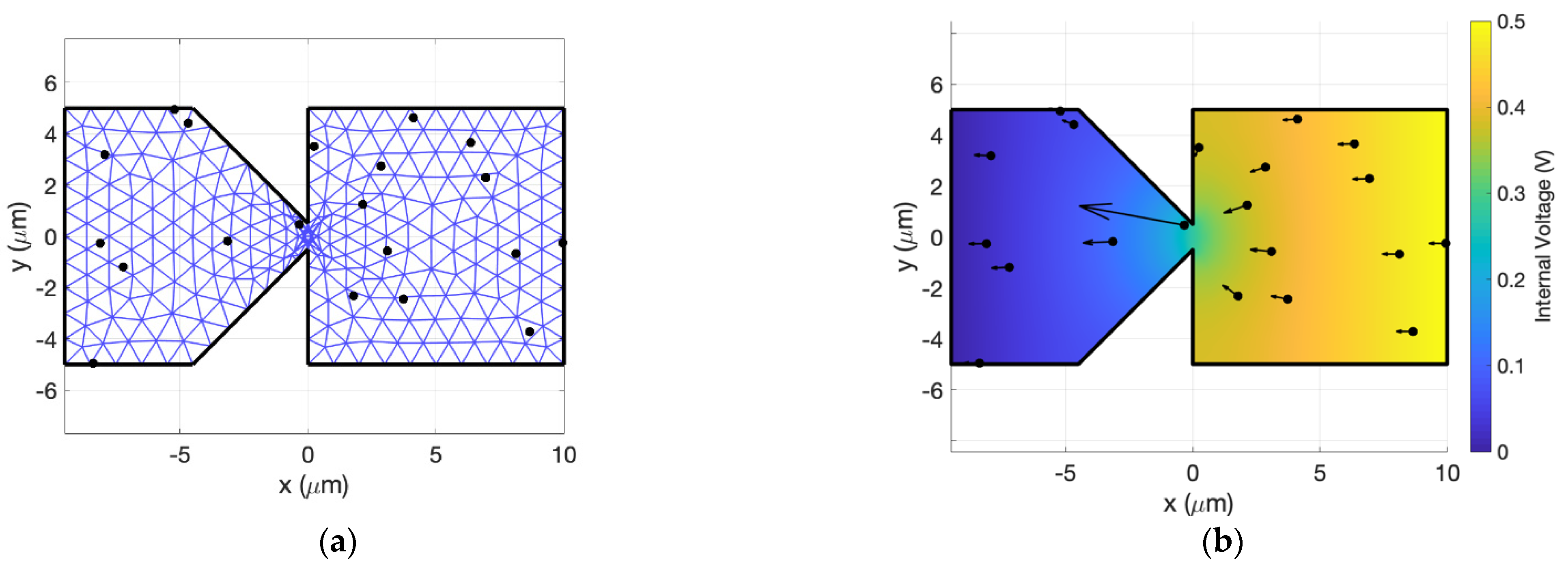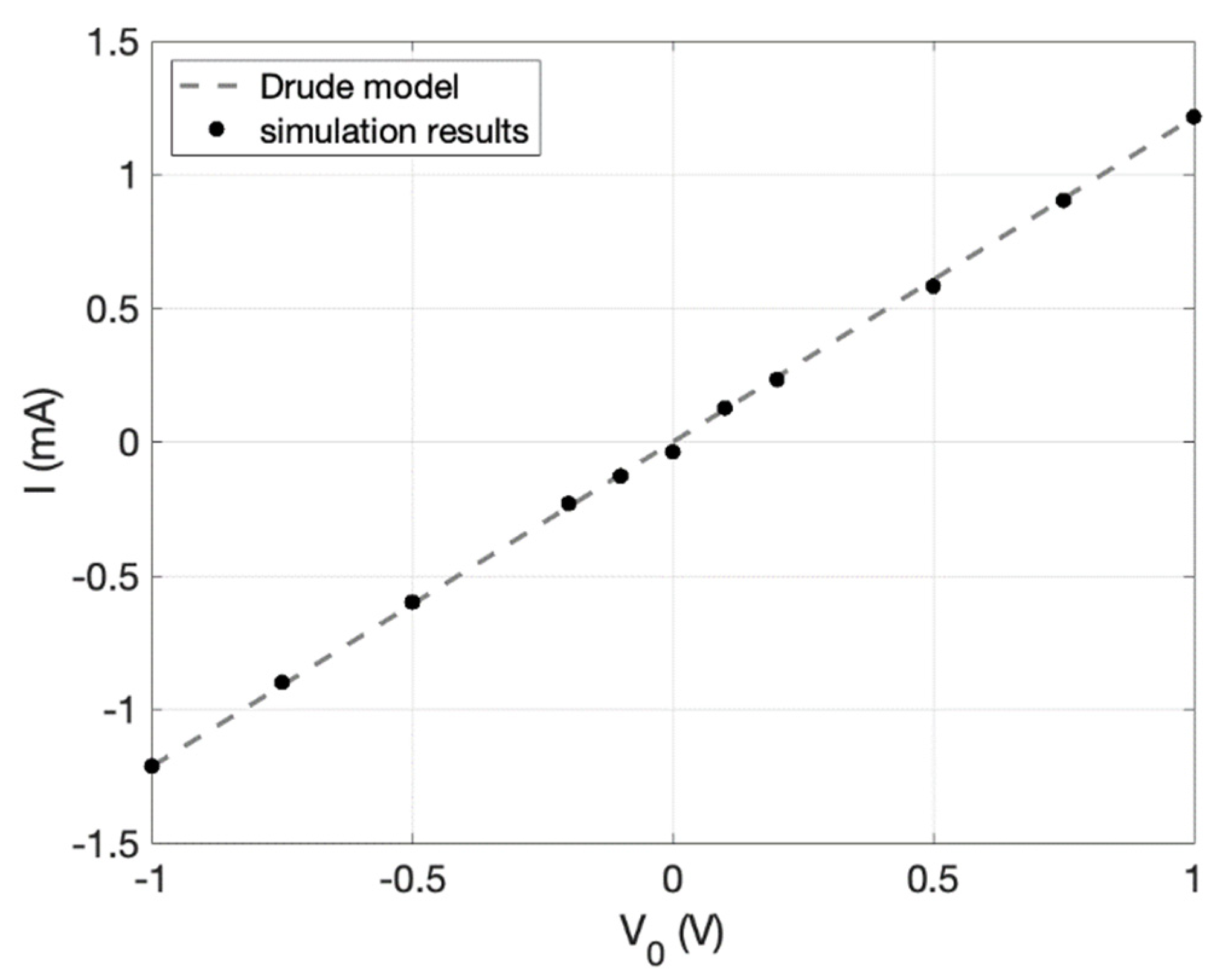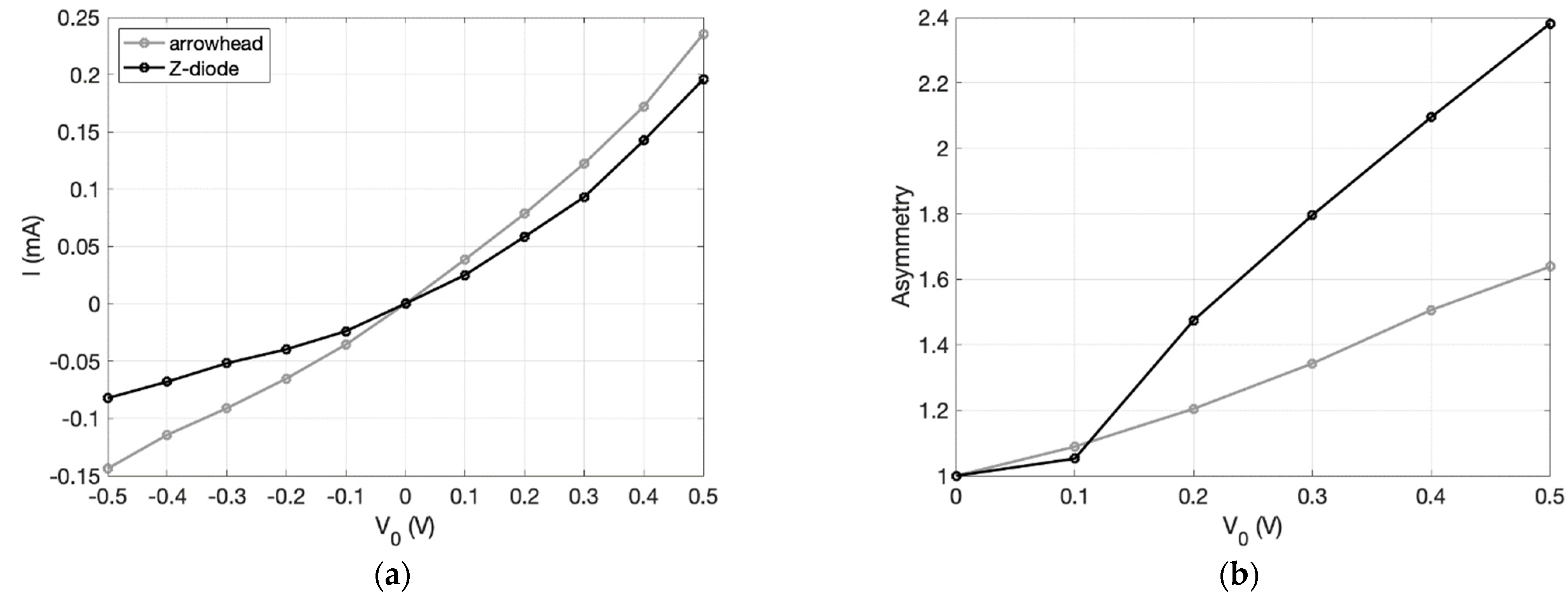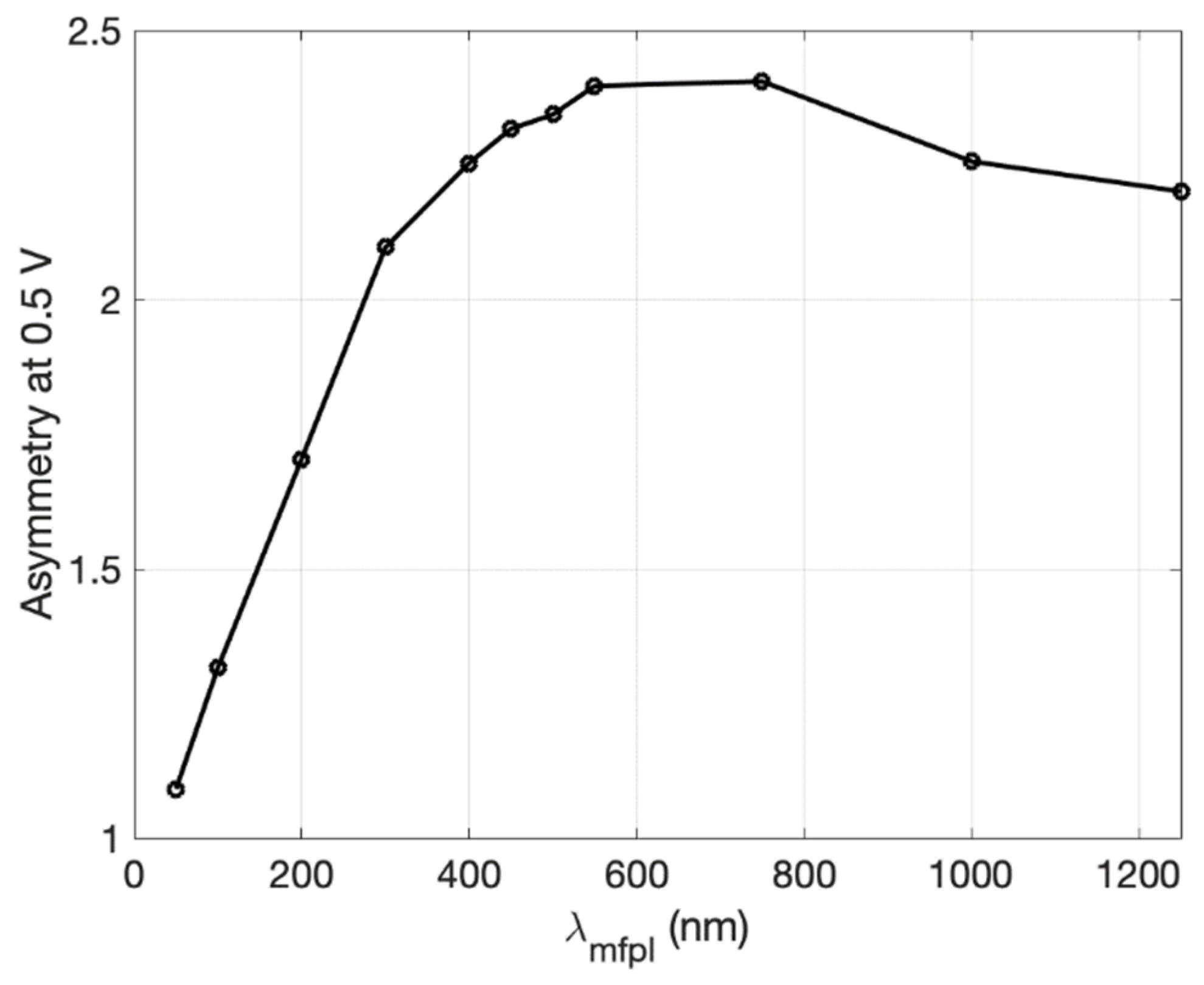1. Introduction
We defined geometric diodes as planar conductors patterned with a geometric asymmetry that gives rise to a preferred current direction in 2008 [
1], and we have demonstrated that they rectify at DC and infrared frequencies [
2,
3]. Since these diodes are planar and therefore have extremely low capacitance, they have the potential to provide ultra-fast rectification. They can be used in rectennas, diodes coupled to antennas, to rectify infrared signals and produce DC power [
3], and they can also be used in other applications that demand high-speed electronics. Other high-frequency diodes, such as metal–insulator–insulator–metal diodes, have substantially higher capacitance due to their parallel-plate configuration and hence lower operating frequencies [
4] even for ideal materials [
5]. In addition, geometric diodes may be able to achieve higher current asymmetries than other high-frequency diodes [
6].
The mean-free-path length (
λMFP) of charge carriers in the geometric diode material is critical. For a geometric diode to exhibit rectification, charge carriers must travel ballistically (
λMFP greater than device dimensions) or quasi-ballistically (
λMFP near device dimensions) through the patterned material, which requires that device dimensions be on the order of
λMFP or lower. This imposes difficult fabrication requirements for devices made of conventional metals, as typical mean-free-path lengths are below 100 nm. This difficulty can be relaxed somewhat by using more exotic materials, such as graphene, which has shown mean-free-path lengths on the micron scale [
7]. Such graphene devices have been demonstrated experimentally [
2,
3,
8] and are capable of infrared rectification.
Methods of modeling geometric diodes often incorporate the Landauer–Buttiker formalism to obtain device current–voltage (
I(V)) characteristics, using a transmission function obtained theoretically [
9] or through simulation [
10,
11]. This approach is elegant but so far has been applied only to purely ballistic transport and does not include the momentum relaxation that is present in quasi-ballistic devices, which can still exhibit rectifying behavior. Another simulation method incorporates a Monte Carlo algorithm with Drude-like carrier transport through the devices, and it includes momentum relaxation by way of scattering events [
3,
12]. In this approach, the device geometry is established, and the input voltage is applied across the device at the two electrodes in order to compute the geometry-dependent electric field, which is assumed to be constant throughout the simulation time. Then, a certain number of charge carriers, each of which represents multiple electrons, are generated at random locations in the device, each with a randomly directed velocity with magnitude equal to the Fermi velocity (
vF). Then, the carriers are allowed to move under the influence of the electric field over a small timestep, with the electric field perturbing their initial randomly directed momentum. If a charge carrier collides with a device boundary, it undergoes specular reflection and is allowed to continue propagating. If it crosses either of the electrodes, then a counter is incremented before another carrier is injected from the opposite electrode. Once a certain carrier has traveled a distance equal to the mean-free-path length, it is given a new randomly directed velocity, with magnitude
vF, and the process repeats for a predetermined number of time steps. After a chosen time has elapsed, the current is derived from the counter and the total simulation time.
We present a new simulation method that incorporates a particle-in-cell algorithm (PIC) [
13] to determine the
I(V) characteristic for a given device. This method, which builds on the previous Monte Carlo method [
3], decreases the computation time and includes a self-consistent electric field computation at every time step. Our application of this method also includes a more accurate implementation of the collision time statistics from the Drude model. Since this algorithm includes momentum relaxation, it is useful for the simulation of both ballistic and quasi-ballistic devices. Our previous simulations and demonstrations made use of an inverse-arrowhead design [
3]. Here, we use this simulator to demonstrate a new diode geometry, the Z-diode, which shows improved current asymmetry over previous designs.
2. Materials and Methods
The simulation begins by establishing the diode boundaries in MATLAB [
14] and creating a triangular mesh within them. The nodes of the mesh are the discrete points at which the charge concentration, electric potential, and electric field will be computed later in the algorithm. Then, a certain number of macroparticles, each of which can represent multiple electrons, are scattered within the device at random locations. The use of macroparticles, where each one typically represents 100 or 200 individual electrons depending on the carrier concentration of the material, facilitates quicker computation than simulating individual carriers. Each macroparticle is initially distributed to the three mesh nodes surrounding it using a weighting determined from the relative distances between the particle and each of the nodes. This establishes the initial spatial charge density. There is assumed to be a homogenous distribution of background positive charge that maintains charge neutrality in the device as a whole. Each of the macroparticles is initiated with a randomly directed velocity vector with magnitude equal to
vF. The probabilistic nature of electron collisions is incorporated by assigning each macroparticle a time interval in the future at which it will undergo a momentum relaxation event. These times are sampled from an exponential decay distribution where
e−t/τ represents the probability that an electron picked at random will have no collision during the next time interval
t, and
τ = λMFP/vF represents the average momentum relaxation time of the choice material [
15].
The input voltage is set as a boundary condition between the two electrodes. MATLAB’s PDE package is used to solve Poisson’s equation for the potential at every mesh node. Then, the electric field is computed from the gradient of the solution. Then, the field at each particle is determined from the field at the surrounding three nodes using the distance weighting that was used for the charge distribution. The field exerts a force on the particle, changing its velocity over a small time-step
dt, and the particles hop forward in time along the new velocity vector. The counter that tracks the time at which a given particle will undergo a momentum-destroying collision is decremented by
dt for each particle. The new locations of the particles are used to compute the charge density again, and the process repeats itself many times. This methodology, which is usually incorporated in PIC algorithms, computes inter-particle interactions through the spatial charge density rather than through Coulombic forces between particle pairs, which would be more computationally expensive.
Figure 1 shows the setup and results graphically for an inverse-arrowhead diode shape [
3]. Note that for clarity, the figure contains only 20 macroparticles, but in full simulations, hundreds are used. For the simulations described herein, we always ensured that a sufficient number of macroparticles were used so that the results did not change with a further increase in the number of macroparticles. For a lower number of macroparticles, each macroparticle represents a larger number of individual electrons. Since inter-electron forces are not considered among electrons within the same macroparticle, more electron interactions are ignored and care must be given to ensure error is not introduced.
At any step, if the time-to-next-collision counter goes below zero for any particle, that particle’s momentum is reset by giving it a new randomly-directed velocity with magnitude
vF, and its counter is reset from a sampling of the exponential decay distribution. The new counter value is reduced by the amount of time the particle traveled after the collision event, i.e., the previous negative value of the counter. This ensures that the momentum relaxation statistics are obeyed throughout the simulation and, on average, the particles will travel approximately a distance of
λMFP between collisions. If a particle collides with a device boundary, it is reflected specularly and continues propagating. When a particle crosses one of the electrode boundaries, a counter,
Q, which counts the total number of charges to pass through the device throughout the entire simulation, is incremented or decremented accordingly. Then, the total current,
I, is computed as,
where
n is the material’s free carrier concentration per unit area,
A is the total device area,
Nmacro is the number of macroparticles used in the simulation,
q is the elementary charge, and
Nt is the total number of simulated time steps.
It is important to note that
dt must be chosen carefully with regard to
τ. Since a particle’s collision counter is decremented by
dt at every timestep, for larger
dt, there is a larger margin by which a particle’s collision counter can drop below zero. This corresponds to the particle overshooting its actual collision location, which results in an unintentional increase in the distance traveled between collisions. Then, the simulated current will be overstated due to an artifactual increase in mobility. To avoid this problem, mesh elements must be small enough to capture the large potential gradients that occur at geometric constrictions in the device (see the large electric field acting on the particle near the constriction at
x = 0 in
Figure 1b). If the mesh is too coarse, large potential gradients (electric fields) will be understated and yield a lower simulated current. On the other hand, arbitrarily small timesteps and mesh sizes require long simulation times. For each geometry, we repeated simulations for decreasing
dt and mesh size to find values for each where the resulting
I(V) remained approximately constant with further reductions. Once we determined a sufficiently small timestep and mesh size to give a grid-independent solution for a given geometry, we used them for all subsequent simulations of that geometry. A time step of
was used for all simulations herein. For devices with geometric constrictions, the mesh element size varied throughout with a larger mesh size near the electrodes and a smaller mesh size near the constrictions.
4. Discussion
The simulation method described here presents several advantages compared to existing simulation methods. It is useful in studying the rectification behavior of diodes that operate in the quasi-ballistic regime and does not assume fully ballistic transport as do the other methods discussed in the introduction. In addition, it includes the effects of electric fields that result from inhomogeneous charge distributions and is computationally more efficient than existing Monte Carlo simulation methods.
It is important to note several factors and assumptions involved in the simulation that can compromise its validity in certain situations. This method assumes that the Fermi level of the charge carriers relative to the Dirac point,
EF, is much larger than
kBT. Here,
kB is the Boltzmann constant and
T is the ambient temperature. In this assumption, all of the carriers are assumed to have energy given by
EF with negligible spread. In the case of graphene, the Fermi level is given by
EF = m*m0vF2 [
19], which in our case gives
EF = 100 meV, which is larger than
kBT by a factor of 4 at room temperature.
This simulation method also neglects quantum effects due to the wave nature of electrons. The de Broglie wavelength can be used to determine the length scales below which wave-like properties of the charge carriers become important. From the relation
EF = ℏkvF [
19], where ℏ is the reduced Planck constant, and
k is the carrier wave vector, we have
k = 150 μm
−1 for the above simulations, which translates to a de Broglie wavelength of 40 nm. This, along with the large coherence lengths reported for graphene [
20], suggests that interference effects due to the wave nature of the electrons become important for device dimensions below the 100 nm scale. The de Broglie wavelength varies with the gate voltage, decreasing for greater
Vg, and can therefore be controlled to some extent.
At high electric fields, saturation effects due to high-energy charge carriers exciting optical phonons need to be accounted for [
21]. For the parameters assumed in these simulations, i.e.,
Vg = 10 V for graphene on a 300 nm thick SiO
2 substrate at room temperature, saturation effects become strong for applied fields around 0.5 V/μm [
21]. For micron-sale devices, this simulation method should not be used with applied voltages exceeding the 1 V scale. The resulting current will be overstated as velocity saturation is ignored.
5. Conclusions
In our simulation approach, macroparticles are used to determine the potential and electric field at every mesh node in the device, and the particles move under the influence of the electrostatic forces. Each macroparticle’s momentum is periodically destroyed, and its direction is randomized before moving under the influence of the electric fields. The simulator is run over many collisions, and the current is derived from the rate at which the macroparticles traverse the device. By including momentum relaxation, it is applicable to quasi-ballistic transport as well as ballistic transport, and therefore, it can be used to predict the behavior of a wider range of devices than if the momentum relaxation was not included. It is also computationally more efficient than existing Monte Carlo simulation methods. The simulator has certain limits to its applicability. For very small device features, below 100 nm for the material properties used here, quantum effects can begin to take hold and cause erroneous simulation results. For graphene, the simulator will also overstate the current for electric fields over 0.5 V/μm due to its neglect of saturation effects.
Through simulation, we have studied a new geometric diode design, the Z-diode, which exhibits improved rectification over 0.1 V compared to the previous inverse-arrowhead design. It was found that the current asymmetry of such diodes is sensitive to the device dimensions relative to the carrier mean-free-path length. In particular, for a given Z-diode size, there exists a finite mean-free-path length that maximizes the current asymmetry at a particular voltage, which is a result that has previously not been discussed in the literature. Equivalently, this suggests that given a material with a specified mean-free-path length, the critical dimensions of the diode can be tuned to maximize asymmetry.











